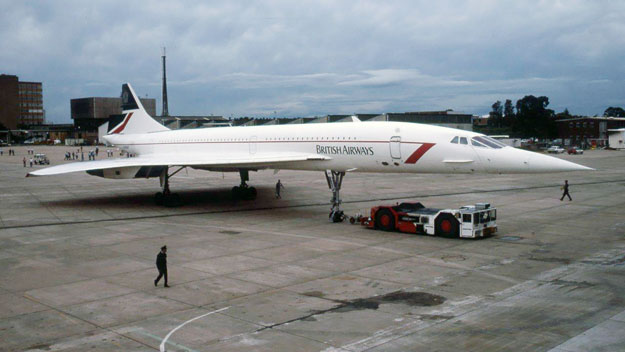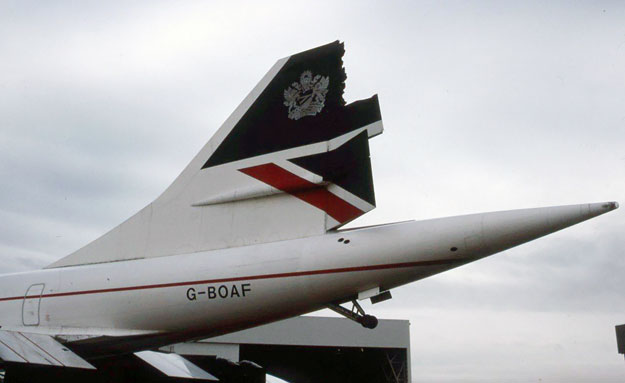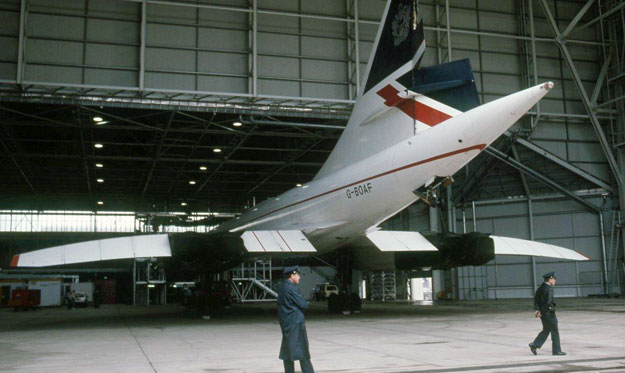
The following account of the loss of part of its upper rudder by BAC/Aerospatiale Concorde G-BOAF on a flight from Christchurch, NZ, to Sydney, Australia on 18 April 1989 is taken from British Airways Air Safety Review for September/October 1989.
The photographs were taken at Sydney by Ken Watson, at that time a Qantas Engineer.
Concorde/951 G-BOAF BA9051C
Flight: Part of top rudder detached
Christchurch/Sydney 12 Apr 89
0140 UTC
The Captain reported that at about FL440 during the climb, when the aircraft's speed was just over Mach 1.7, a thud was felt, similar to a bird strike which seemed to come from under the flight deck floor.
All the flight deck instrumentation appeared to be normal and it was considered that it was possibly caused by a minor engine surge. The flight was continued towards Sydney without any abnormal indication or sound until, during the descent and deceleration, after the throttles
had been retarded, a medium level vibration started at about Mach 1.3. As the indicated parameters for Nr 4 engine had been very slightly different from those of the other engines, it was considered that it may have been the cause of the vibration and so it was throttled back to idle, but this had no effect on the vibration. All the other engine throttles were then retarded and the speed reduced, but again, this did not affect the vibration. About 1 3/4 minutes after the vibration started, it reduced and was not apparent for about 15 seconds but it again recurred. The vibration then became intermittent and about 2 1/2 minutes after it had initially started the vibration ceased. During the period of vibration, the aircraft's speed had decreased from Mach 1.3 to Mach 1.0, but the aircraft's handling was normal throughout. The descent was continued and an ILS
approach to [Sydney] runway 34 was carried out and the aircraft landed normally. An emergency vehicle parked adjacent to the end of the runway, had observed that part of the rudder was missing and reported to ATC who then alerted the emergency services and informed the flight
crew. The emergency services arrived at the aircraft within about 30 seconds and RTF contact was maintained, both with the tower and the emergency services.
An investigation into the incident was carried out by the Air Accidents Investigation Branch, (AAIB) British Airways Air Safety Branch and the Technical & Quality Services Branch.
The damaged top rudder was removed and after detailed checks were carried out the aircraft was returned to service. Examination of the rudder removed from the aircraft showed that the
failure had been limited to the upper part of the rudder which is constructed from skin panels bonded to a honeycomb core. The front spar hinges and PFCU attachment structure was unaffected, as was the rudder surface and honeycomb below this point. A wedge shaped
trailing edge extension had been fitted to all the Concorde rudders by British Aerospace and this modification was carried out on G-BOAF on delivery of the aircraft to British Airways using break head blind rivets to attach the wedge. Examination of the remaining part of the upper rudder showed that the required wet assembly and sealing requirements for the rivets had not been fully complied with and this had permitted moisture to enter the bonded structure of the rudder. This had resulted in corrosion and delamination of the skins from the honeycomb core. It is considered that the incident occurred when the delamination had spread over a very large area of the rudder which had progressively reduced the stiffness of the surface until it was inadequate to withstand the in-flight stresses.
The missing parts of the rudder were lost in the Tasman Sea and have not been recovered.

Analysis of the recorded flight data indicates that the noise heard during the climb was caused by minor engine instability. It is considered that the rudder remained intact until the descent when it
failed progressively and resulted in the reported vibrations.
There is no record of the rudder being removed from the aircraft since it was fitted following the attachment of the trailing edge extension. The rudder had been subject to paint stripping and repainting in 1981 and 1985 and it is considered possible that any surface sealing of the blind rivets holding the extension to the rudder may have been affected by the stripper. However, if the rivets had been correctly wet assembled this would not have affected their ability to prevent moisture ingress. At the time of the incident the aircraft had flown 8333 hours and there was no scheduled inspection for delamination of the rudder until 12 000 hours.
Following the report of the failure all Concorde rudders and elevons, which are of a similar construction, were checked for delamination prior to the next flight. The upper rudder of aircraft G-BOAB, which was undergoing maintenance at the time, was found to have delamination at the trailing edge of the upper rudder. This was limited to an area not more than three inches wide along most of the trailing edge. This degree of delamination is not considered to have significantly
affected the structural stiffness of the rudder. The delamination, which had also occurred through moisture ingress through incorrectly sealed blind rivets was repaired prior to flight.

Back to the main Air Safety & Accidents index
Back to the main Items of General Interest index
If this page appears without a menu bar at top and left, click here